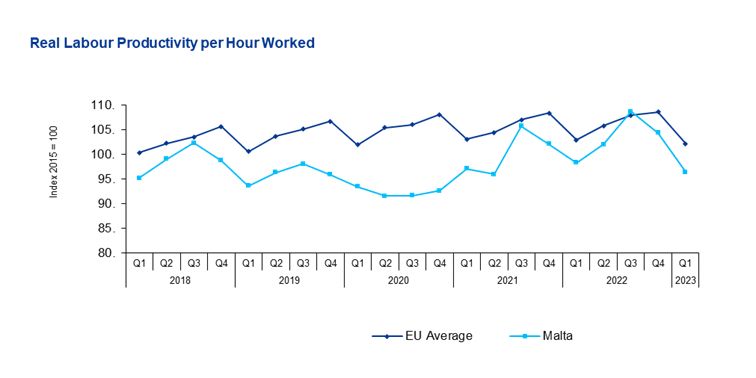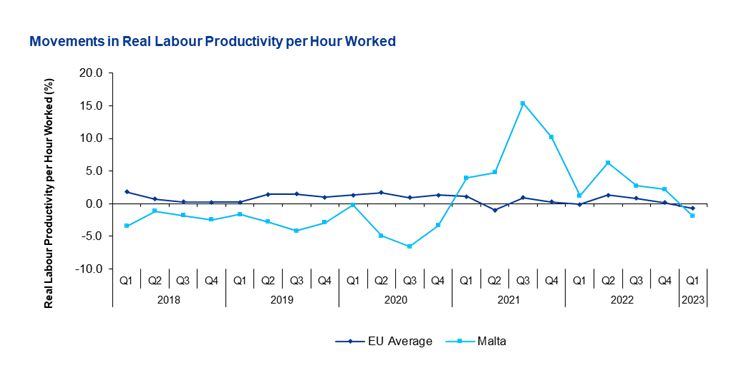The Malta Employers’ Association (MEA) recently commented that wage increases in Malta are not in step with movements in labour productivity1.
Labour productivity is a critical determinant of economic growth and refers to the amount of output produced per unit of labour input. Industries and economies with high labour productivity generally achieve greater competitiveness, increased output, and improved standards of living.
Understanding the factors influencing labour productivity is vital for policymakers, businesses, and individuals, as it drives innovation, shapes employment trends, and contributes to overall socio-economic development.
Defining Labour Productivity
The Organisation for Economic Cooperation and Development (OECD) defines labour productivity growth as growth in GDP per hour worked in an economy2. Labour productivity is mainly determined by:
- Physical capital - such as investments in machinery and equipment;
- Human capital - which mainly refers to education and training; and
- Technological change - defined as an increase in the efficiency of a product or process that results in an increase in output, without an increase in input.
Some other measures of labour productivity include real GDP per person employed, real GDP per capita, and hours worked per employed person.
A holistic overview of labour productivity would require an in-depth analysis of all these measures. In this article, we focus on the definition of labour productivity as being real GDP per hour worked, in order to present an introduction to the topic.
Labour Productivity in Malta and the EU
The following chart compares the real GDP per hour worked in Malta vis-à-vis the EU average. As can be noted, average labour productivity per hour in the EU is higher than in Malta.
Nonetheless, similar patterns can be noted, whereby productivity decreased during the pandemic, increased immediately thereafter, and declined over the more recent quarters.

Source: Eurostat Data; KPMG Analysis
If one were to look at the movements in real GDP per hour worked, it can be noted that movements in labour productivity across the EU were smaller and less volatile, although as commented earlier the average labour productivity in the EU stands higher.
During 2023 Q1, labour productivity locally contracted by 1.9% while the average for the EU contracted by 0.7% during 2023 Q1.

Source: Eurostat Data; KPMG Analysis
Why is labour productivity stalling?
Over the past decade Malta has increasingly moved away from industry towards the services sector, where, with some notable exceptions such as financial services and iGaming, the average value added per worker is relatively lower3, according to the International Labour Organisation. The nature of the jobs performed by the labour force also matters, in that the more elementary the job, the lower the value-added, and hence the lower the productivity of that job.
Why does it matter?
Improvements in labour productivity are important to drive economic growth because it allows an economy to produce more with the same amount of resources or to produce the same amount of goods and services with fewer resources over time. This is particularly important when looking at ways of improving long-term sustainability without jeopardising our existing standards of living.
Increased labour productivity also allows Maltese firms to compete successfully on the international market, and in the longer run translates to higher wages and better working conditions for employees.
Finally, increased productivity also yields higher tax revenues for the government.
How can we improve labour productivity in Malta?
At the firm level, labour productivity improvements can be attained by, for instance, investing in digital tools, rolling out employee training programmes, process redesign, or creating a culture conducive to high performance. Often enough, this can be done by simple and cost-effective steps such as small investments in technology and processes.
On the other hand, at a national level, significant improvements in labour productivity can only be attained through a concentrated and sustained effort to divert our already limited resources towards higher value-added economic sectors. In order to achieve this, the government would need to plan long-term and:
- Reassess Malta’s economic model and its alignment to such an objective.
- Create policies that incentivise a shift to higher value-added economic sectors.
- Improve Malta’s educational system so that Malta’s human capital (both that of today and that of tomorrow) are suitably (re-)skilled to be the creators of, as well as the operators in, higher value-added industries.
[1] https://timesofmalta.com/articles/view/productivity-no-match-wage-increases-survey.1046602
[2] https://data.oecd.org/lprdty/labour-productivity-and-utilisation.htm
[3] International Labour Organization – World Employment and Social Outlook Trends 2020


